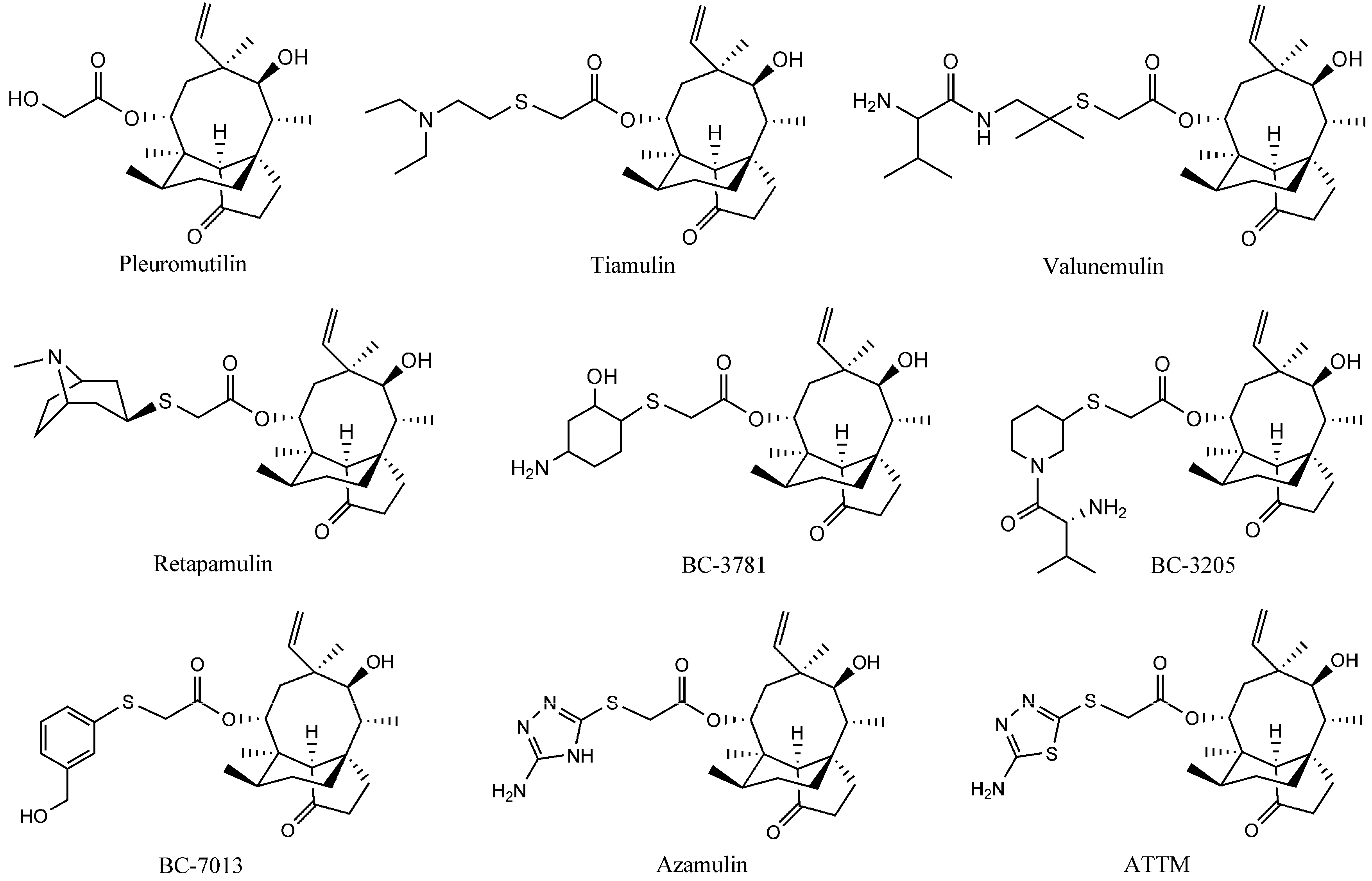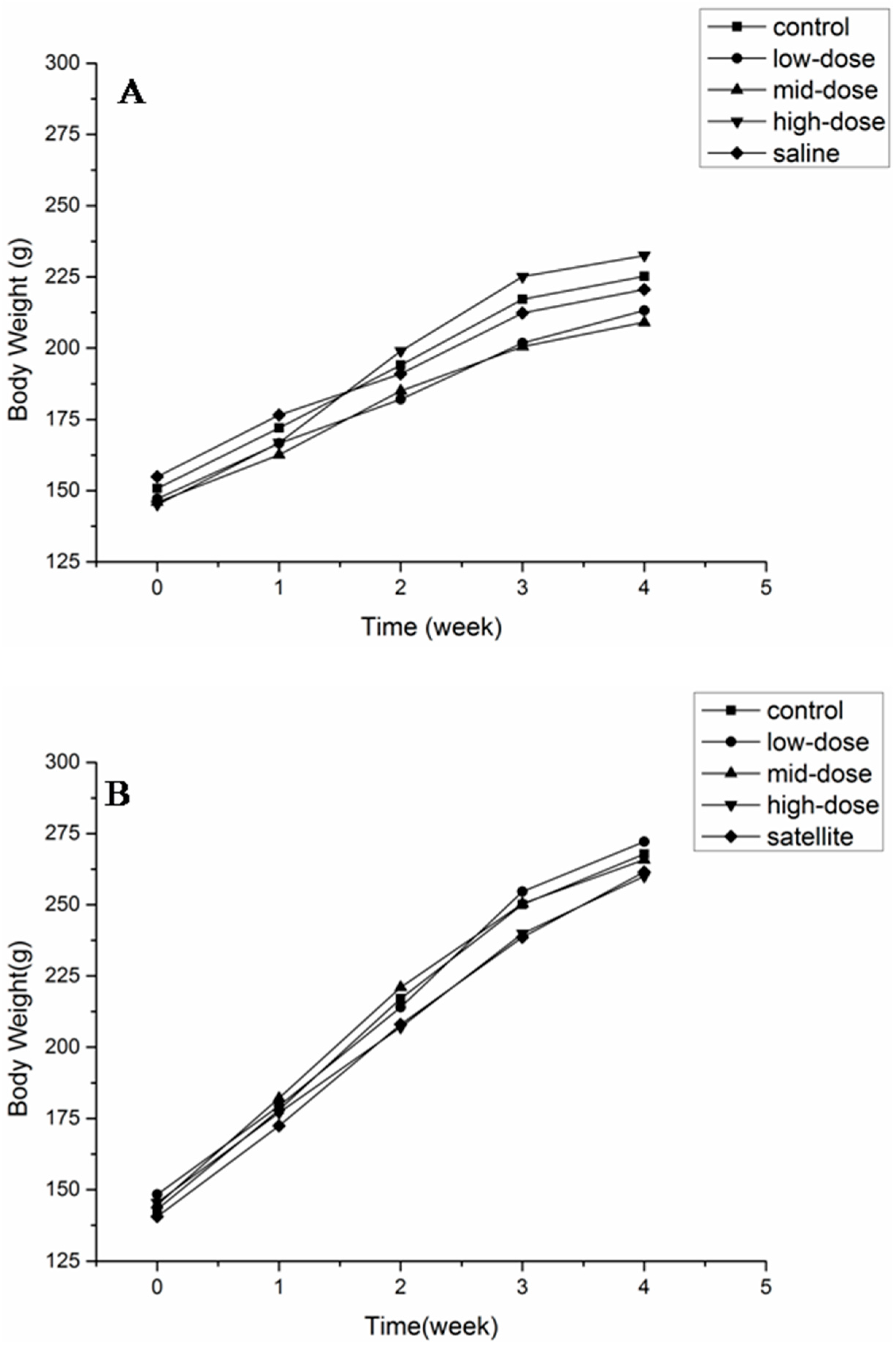1. Introduction
The increasing resistance of bacteria to the major classes of antibacterial drugs is becoming a serious threat to public health. Drug-resistant bacteria, especially methicillin-resistant
Staphylococcus aureus (MRSA), currently cause infections in both hospitals and the worldwide community [
1]. Therefore, new classes of antibacterial agents that work via novel mechanisms are urgently needed to effectively eradicate drug-resistant bacteria.
The natural compound pleuromutilin (
Figure 1) was first discovered and isolated from cultures of two species of basidiomycetes,
Pleurotusmutilus and
P. passeckerianus, in 1951 [
2]. Modifications of pleuromutilin have led to three drugs: tiamulin, valnemulin, and retapamulin (
Figure 1) [
3,
4]. Extensive efforts were made to synthesize three other compounds, BC-3781, BC-3205 and BC-7013 (
Figure 1), for human use after the success of retapamulin [
5,
6]. Chemical footprinting studies showed that tiamulin and valnemulin bound to the bacterial ribosome at the peptidyl transferase center (PTC), thereby inhibiting the synthesis of the peptide bond by hindering the correct location of the amino acid on the tRNA [
7,
8]. Further studies demonstrated that the interactions of the tricyclic core of tiamulin are mediated through hydrophobic interactions and hydrogen bonds, which are formed mainly by the nucleotides of domain V [
9,
10].
Figure 1.
The structures of the pleuromutilin derivatives and ATTM.
Figure 1.
The structures of the pleuromutilin derivatives and ATTM.
A new pleuromutilin derivative, 14-
O-[(2-amino-1,3,4-thiadiazol-5-yl) thioacetyl] mutilin (ATTM,
Figure 1) is composed of a rather rigid 5-6-8 tricyclic carbon skeleton and a thiadiazole moiety [
11]. This compound was structurally similar to azamulin (
Figure 1), which was designed for human use during the early 1980s but did not undergo further clinical trials because of its poor solubility in water and its strong inhibition of human cytochrome P450s [
12,
13]. ATTM was first synthesized and evaluated in our lab. The
in vitro antibacterial studies showed that it displayed excellent antibacterial activity against MRSA, methicillin-resistant
Staphylococcus epidermidis (MRSE) and
Streptococcus agalactiae (
S. agalactiae). Preliminary pharmacokinetics studies in rats showed that ATTM may be able to serve as a possible lead compound for the development of antibacterial drugs [
14]. This present report describes a subsequent pharmacological investigation of ATTM, including studies of the
in vivo efficacy and acute toxicity in mice, and subchronic toxicity in rats.
3. Experimental Section
3.1. Preparation of ATTM
ATTM was synthesized in our lab, as previously reported [
14]. The synthesis of ATTM begins from 22-
O-tosylpleuromutilin, which was obtained by the reaction of pleuromutilin and p-toluenesulfonyl chloride to activate the 22-hydroxyl of pleuromutilin. The intermediate, 14-
O-(iodoacetyl)-mutilin was prepared in good yield under reflux for 3 h in acetone. Finally, ATTM was obtained in 82% yield by the nucleophilic attack of 2-amino-5-mercapto-1,3,4-thiadiazole on 14-
O-(iodoacetyl)-mutilin under alkaline conditions.
3.2. Animals
Adult specific pathogen free (SPF) Kunming mice (weighing 18–22 g) and Sprague-Dawley (SD) rats (aged 3–4 weeks, weighing 140–160 g) were purchased from the Laboratory Animal Center of Lanzhou University (Lanzhou, China) and maintained under controlled temperature conditions (23 °C), with a constant 12 h light-dark cycle and free access to food and water. The experimental procedures were performed in accordance with the Ethical Principles in Animal Research and were approved by the Committee for Ethics in the Laboratory Animal Center of Lanzhou University (number: SCXK2013-0002).
3.3. In Vivo Efficacy in a Mouse Model
Male and female mice were rendered neutropenic upon treatment for four days with 150 mg/kg cyclophosphamide intraperitoneally followed by 100 mg/kg for one day, after they had been acclimated for five days. The neutropenic mice (10 per group) received a 0.5 mL MRSA inoculum of 10
9 CFU/mL via intraperitoneal (ip) injection. At one hour post infection, the mice were then intravenously (iv) administered ATTM dissolved in 0.5 mL vehicle (soybean lecithin: sterile water = 1:30) at doses of 2.5, 5, 10 and 20 mg/kg b. w. Tiamulin fumarate was used as a control in the same manner and at the same doses as ATTM. The survival of mice at 72 h after infection was used as the end point and the ED
50 was calculated by the method described by Reed Muench [
17] using the Hill equation.
3.4. Acute Oral Toxicity in Mice
Thirty male and thirty female SPF Kunming mice were stratified by weight and randomly assigned to six groups: five treatment groups and one vehicle control group, with five male and five female mice for each group. The vehicle control group received DMSO in a volume of 20 mL/kg b. w. by oral gavage. The ATTM was dissolved in DMSO and administered to the mice at doses of 948.15, 1422.22, 2133.33, 3200.00 and 4800.00 mg/kg body weigh, respectively, and all animals were observed twice daily for symptoms and mortality for one week. The vehicle control group was observed at the same time. All of the surviving animals were euthanized at the end of the study, and their vital organs were individually observed for overt pathology by necropsy, and the LD50 was calculated by the Bliss method on day 8.
3.5. Subchronic Oral Toxicity
3.5.1. Experimental Design
A total of 100 healthy male and female SD rats (140–160 g) were selected and randomly divided into five groups (20 rats in each group, male: female = 1:1) after one week of acclimatization. One group of rats was assigned to serve as control group, and these animals received DMSO in a volume of 4 mL/kg b. w., and another group was assigned to a saline group and received physiological saline in the same volume as the DMSO by oral gavage. The other three groups were assigned to ATTM treatment groups, and received ATTM via oral gavage at doses of 5, 25 and 125 mg/kg b. w. per day (at the same time each day ± 1 h). The animals in all groups were used for 28-day subchronic toxicity study, and were observed once daily to detect signs of toxicity. The animals’ body weight and food consumption were measured every week during the whole observation period, and the gavage volume was adjusted based on the last measured body weight.
3.5.2. Clinical Signs, Body Weights and Food Consumption
The rats were observed for behavioral changes, mortality, and symptoms and signs of gross toxicity at least once per day during the 28-day subchronic toxicity study. The individual body weights of the rats were measured and recorded at least once a week. The mean weekly body weight gain was calculated for each sex and dose level during the entire test period. Individual food consumption was measured and recorded weekly. The mean daily food consumption was calculated for each sex and dose level for each weekly interval and for the overall test period.
3.5.3. Blood Analysis
At the end of the experiment, blood was collected from the femoral artery in ethylenediaminetetraacetic acid (EDTA) coated tubes for hematology studies and in non-oxalate tubes for the separation of serum on the 29th day following a 12-h fast. The hematological analyses included the white blood cell (WBC), red blood cell (RBC) counts, the hemoglobin (HGB) and hematocrit (HCT) levels, mean corpuscular volume (MCV), mean corpuscular hemoglobin (MCH), mean corpuscular haemoglobin concentration (MCHC) and number of platelets (PLT), which were determined using a Poche-100iv Diff instrument (SYSMEX, Kakogawa, Japan).
The other blood collected in non-oxalate tubes was centrifuged at 3500 rpm (15 min at 4 °C) and the supernatant (serum) was collected and introduced into new tubes for the subsequent biochemical analyses of the levels of alanine transaminase (ALT), ALP, aspartate transaminase (AST), total bilirubin (T-Bil), lactate dehydrogenase (LDH), total cholesterol (TC), high density lipoprotein (HDL), low density lipoprotein (LDL), triglycerides (TG), creatine kinase (CK), CR, urea nitrogen (Urea), uric acid (UA), total protein (TP), albumin (ALB), GLU, Ca and P. These were measured using reagent kits and a Mindray BS-420 auto hematology analyzer (Mindray Corporation, Shenzhen, China).
3.5.4. Necropsy, Organ Weight and Histopathology
Finally, the rats were anesthetized using an excess of CO2 anesthesia, followed by exsanguinations. The gross pathological changes were recorded for each rat, and the heart, liver, kidneys, spleen, thymus, lungs, testes and ovaries were collected, weighed and the relative weights (organ weight (g)/100 g b. w.) were recorded. Histopathological examinations were performed on the heart, liver, kidneys, spleen, thymus, lungs, testes or ovaries and small intestines of each rat.
3.6. Statistical Analysis
The data were expressed as the mean ± standard deviation (SD) and were analyzed using the SAS statistical software package (Version 9.0; SAS Institute, Cary, NC, USA) to account for the effects of ATTM on the weight, hematological findings and organ effects. A parametric one-way analysis of variance (ANOVA) for repeated measures was used to examine intergroup differences. When a significant difference (p < 0.05) was found, Tukey’s test was used to compare the means.
4. Conclusions
Historically, the semi-synthesis of new compounds based on natural products, especially complex natural products, has been the predominant avenue to the development of new antibiotics. The chemical modifications of pleuromutilin were made in an attempt to improve the antimicrobial activity and in vivo efficacy of the compounds after the identification of the structure of pleuromutilin. ATTM, a new derivative of pleuromutilin bearing a thiadiazole moiety, was synthesized in our lab. The in vivo efficacy study showed that ATTM exhibited potent activity, with an ED50 of 5.74 mg/kg b. w. when used to treat MRSA infected mice. Moreover, a study in mice showed no evidence of acute toxicity after the administration of an oral dose of up to 948.15 mg/kg b. w. of ATTM, with an approximate LD50 of 2304.4 mg/kg determined by the Bliss method. No animals died and no clinical abnormalities were observed that were considered to be associated with the 28-day treatment. Most of the hematological and serum biochemical data showed no differences between the treated groups and control group. Some toxic effects could be found in the liver, spleen and kidneys in the high-dose group by the histopathological examination, but these were not considered treatment-related. Our results show that ATTM fed at 5 mg/kg for 28 days is generally considered to be safe for rats.
The above results show that ATTM has a relatively high efficacy in vivo and has a low toxicity profile as a new candidate drug. However, other laboratory studies based on protocols by regulatory agencies should be performed to evaluate the drug potential of this compound.








